To keep pests away from your tea herbs, try using natural remedies like essential oils and companion planting. Essential oils like peppermint, lavender, and tea tree can repel various pests when mixed with water and sprayed. Planting companion herbs such as basil, mint, or rosemary alongside your tea herbs can confuse and deter insects while improving growth. You can also make homemade sprays using garlic and chili for added protection. Diatomaceous earth and vinegar solutions offer further pest control without harmful chemicals. Explore these effective methods to guarantee a thriving herb garden.
Understanding Common Pests
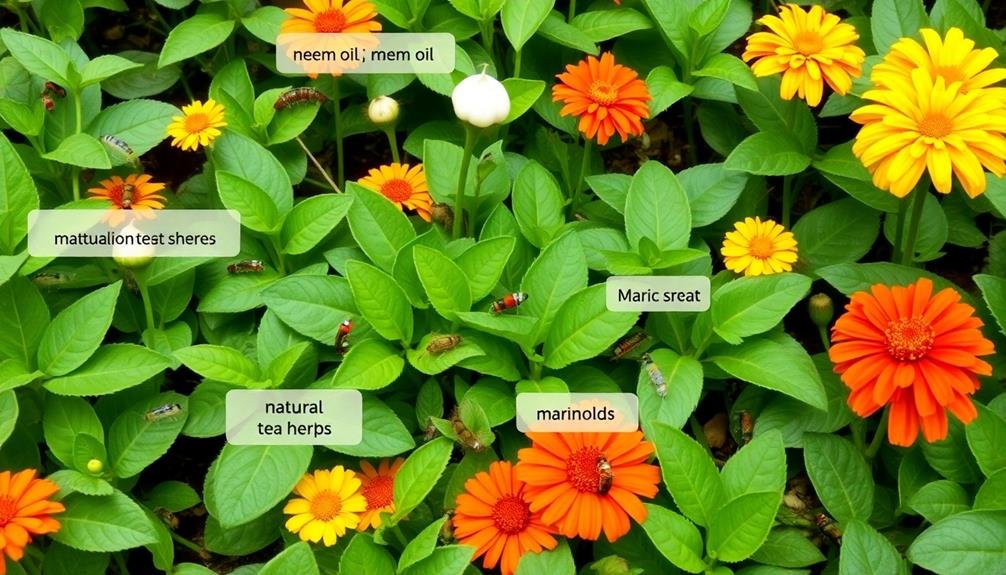
When you grow tea herbs, it's crucial to know the pests that can invade your plants.
Aphids are one of the most common culprits; these tiny insects suck the sap from your herbs, leading to stunted growth. You might also encounter spider mites, which create fine webs and can cause yellowing leaves. If you notice a sticky residue on your plants, it's likely due to these pests.
Another pest to watch for is the whitefly. These small, winged insects tend to congregate on the undersides of leaves, causing similar damage as aphids.
You may also find caterpillars munching on your herbs, which can quickly defoliate your plants if left unchecked.
Root rot is another concern, often caused by overwatering or poor drainage, but it can look like a pest problem.
Be vigilant and check your soil moisture to avoid this issue.
Benefits of Natural Remedies
Utilizing natural remedies for pest control not only protects your tea herbs but also promotes a healthier growing environment. When you choose natural methods, you're fostering biodiversity, which guarantees a balanced ecosystem. This balance helps beneficial insects thrive while keeping harmful pests at bay.
Here are some benefits of using natural remedies:
- Improved Soil Health: Natural methods often enrich the soil, leading to stronger, more resilient plants.
- Enhanced Flavor and Aroma: Healthy, pest-free tea herbs produce leaves with richer flavors and aromas, elevating your tea experience.
- Reduced Chemical Exposure: By avoiding synthetic pesticides, you're protecting your family and pets from harmful chemicals, guaranteeing a safer home.
- Sustainable Practices: Natural remedies promote sustainable gardening, helping you contribute positively to the environment.
Embracing these benefits creates a thriving garden space where your tea herbs can flourish.
You'll find that not only are your plants better protected, but your overall gardening experience becomes more rewarding.
Essential Oils for Repelling

Essential oils are powerful allies in repelling pests from your tea herb garden. By harnessing their natural properties, you can create an effective barrier against unwanted insects. You'll find that oils like peppermint, lavender, and tea tree not only deter pests but can also promote a healthier environment for your herbs.
Here's a quick reference table to help you choose the right essential oils for your needs:
| Essential Oil | Pests Repelled |
|---|---|
| Peppermint | Ants, aphids, spiders |
| Lavender | Mosquitoes, flies |
| Tea Tree | Fungi, mites |
| Eucalyptus | Fleas, ticks |
To use these oils, simply mix a few drops with water in a spray bottle and apply it to your plants. Reapply regularly, especially after rain or watering. Not only do these oils repel pests, but they also add a pleasant aroma to your garden. Embrace the power of essential oils, and enjoy a thriving tea herb garden free from pesky invaders!
Herbal Companion Planting
Companion planting can boost your tea herbs' health and yield by pairing them with the right herbs.
By choosing effective combinations, you'll not only enhance flavor but also deter pests naturally.
Let's explore some of the best herbal pairings and the pest-repelling companions that can protect your garden.
Benefits of Companion Planting
Many gardeners find that pairing certain herbs together not only enhances their growth but also helps deter pests naturally. This practice, known as companion planting, creates a harmonious garden environment where plants support each other.
When you strategically place herbs next to one another, you can boost flavor and aroma while minimizing pest problems.
Here are some benefits of companion planting:
- Natural Pest Repellents: Some herbs, like basil and rosemary, emit scents that repel unwanted insects.
- Improved Growth: Certain pairings can enhance nutrient uptake, leading to more robust plants.
- Disease Prevention: By interspersing herbs, you can disrupt the lifecycle of pests and reduce the spread of diseases.
- Biodiversity: A diverse planting scheme attracts beneficial insects that prey on pests, creating a balanced ecosystem.
Effective Herbal Pairings
Building on the benefits of companion planting, choosing the right herbal pairings can greatly enhance your garden's health and productivity. When you plant herbs together, they can support each other in various ways, from improving growth rates to boosting flavor profiles.
For instance, if you pair chamomile with your tea herbs, you'll not only enjoy its delicate flowers but also benefit from its ability to improve the health of nearby plants.
Basil and parsley are another effective combination. They can share nutrients and create a more diverse ecosystem, which helps deter pests and attract beneficial insects.
Additionally, mint thrives when planted near cabbage and broccoli, as it naturally repels harmful pests, ensuring your tea herbs remain unharmed.
Consider planting dill alongside your chamomile and lemon balm. This combination can encourage pollinator activity, which is crucial for overall garden health.
Pest-Repelling Companion Herbs
When you incorporate pest-repelling companion herbs into your garden, you'll create a natural barrier against unwanted insects.
These herbs not only deter pests but also enhance the overall health of your tea herbs. By strategically planting them alongside your tea herbs, you'll cultivate a thriving ecosystem that promotes growth and flavor.
Consider adding these pest-repelling companions to your garden:
- Basil: Its strong aroma confuses pests, keeping them at bay.
- Mint: The scent of mint repels ants and aphids, making it a robust choice.
- Rosemary: This fragrant herb deters a variety of insects while attracting beneficial pollinators.
- Thyme: Known for its pest-repelling qualities, thyme can ward off cabbage worms and whiteflies.
Pairing these herbs with your tea plants not only helps in reducing pest populations but also creates a diverse environment.
As you witness the combined beauty and functionality of your garden, you'll appreciate the natural harmony that these companion herbs bring.
With the right combinations, you can enjoy healthier tea herbs and a more vibrant garden ecosystem.
Homemade Herbal Sprays
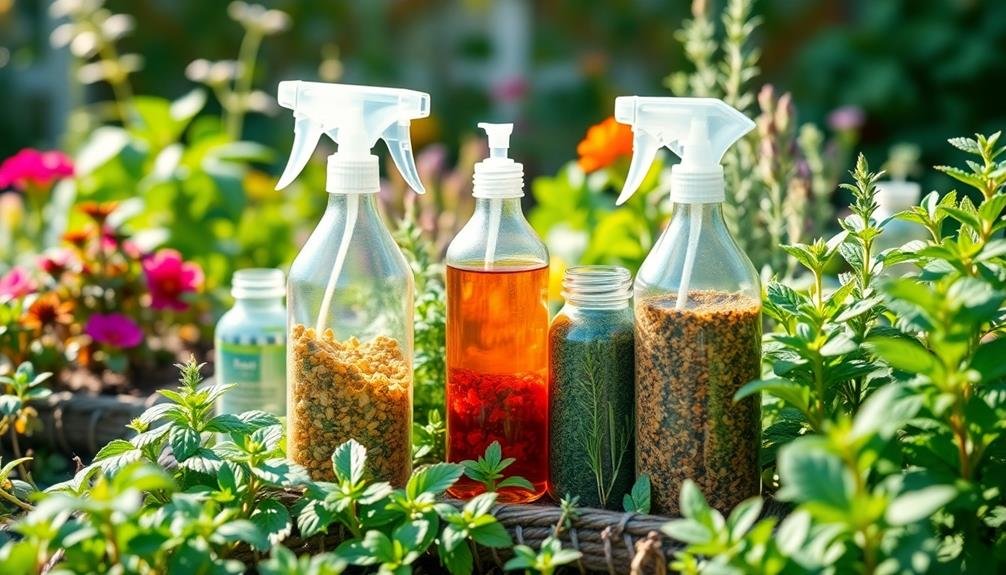
Homemade herbal sprays offer an effective and natural solution for managing pests in your tea herbs. You can easily create these sprays using ingredients from your kitchen or garden.
Start by selecting herbs known for their pest-repelling properties, such as rosemary, mint, or basil. Chop up a handful of your chosen herbs and steep them in boiling water for about 30 minutes.
Once the mixture cools, strain it into a spray bottle. To enhance its potency, consider adding a few drops of liquid soap; this helps the spray adhere to leaves and increases effectiveness against pests.
Before applying, test the spray on a small section of your plants to guarantee they tolerate it well.
Spray your tea herbs early in the morning or late afternoon to avoid sunburn on the leaves. Reapply every few days or after rain, as the natural ingredients can wash away.
Homemade herbal sprays not only deter pests but also provide a pleasant aroma, making your garden a more enjoyable place. By using these simple sprays, you'll help keep your tea herbs healthy and thriving.
Diatomaceous Earth Application
Diatomaceous earth is a natural substance that can help protect your tea herbs from pests.
In this section, you'll learn how to apply it effectively and the safety precautions you should keep in mind.
Let's get started on making your garden a pest-free zone!
What Is Diatomaceous Earth?
One effective solution for pest control in tea herbs is diatomaceous earth, a powder made from the fossilized remains of tiny aquatic organisms called diatoms. This natural substance works by dehydrating and damaging the exoskeletons of insects that come into contact with it.
When you sprinkle diatomaceous earth around your tea herbs, you create an inhospitable environment for pests.
Imagine the benefits of using diatomaceous earth:
- Fine white powder that blends seamlessly into your garden soil.
- Natural and chemical-free, ensuring the safety of your tea herbs for consumption.
- Effective against a variety of pests, including ants, aphids, and spider mites.
- Long-lasting protection, as it remains effective until it becomes wet or compacted.
Using diatomaceous earth not only helps keep unwanted pests away but also maintains the health of your tea herbs.
It's a simple yet powerful tool in your organic pest control arsenal. By choosing this natural remedy, you're promoting a healthier garden environment while ensuring your tea herbs flourish without the interference of harmful insects.
Application Techniques Explained
When applying diatomaceous earth, it's essential to verify you're using the right techniques for maximum effectiveness. Start by selecting a dry day; moisture can reduce its efficacy. Before application, confirm the area around your tea herbs is clean and free of debris, as this allows the diatomaceous earth to work better.
Using a dust applicator or a fine mesh sieve, evenly spread a thin layer of diatomaceous earth around the base of your plants. Aim for a coverage area of about 12 inches around each herb to create an effective barrier. Avoid clumps, as this could hinder its pest-repelling properties.
You can also apply it directly to plant leaves, but be cautious to avoid over-saturation. A light dusting is sufficient, and it's best to reapply after rainfall or watering, as moisture will wash it away.
Monitor your herbs regularly to check for any signs of pests and reapply as needed. By following these techniques, you'll maximize the benefits of diatomaceous earth, keeping your tea herbs safe and thriving.
Safety Precautions to Consider
It's important to keep safety in mind while applying diatomaceous earth, as improper handling can lead to health risks. This natural remedy is effective against pests, but you need to take precautions to protect yourself and the environment.
Here are some key safety measures to take into account:
- Wear a mask: Diatomaceous earth can irritate your lungs, so a mask will help prevent inhalation of the fine dust.
- Use gloves: Protect your hands from irritation by wearing gloves during application and cleanup.
- Avoid windy conditions: Applying diatomaceous earth on windy days can cause it to blow away or into your eyes, leading to potential harm.
- Keep pets and children away: Make sure that your pets and little ones are at a safe distance during and after application to avoid accidental ingestion or contact.
Neem Oil Treatment

Neem oil is a powerful natural remedy for managing pests in tea herbs, thanks to its potent insecticidal properties. When you use neem oil, you're applying a solution that disrupts the life cycle of many common pests like aphids and spider mites. It works by affecting their hormonal systems, which prevents them from growing and reproducing.
To use neem oil effectively, mix one to two tablespoons of neem oil with a quart of water. Adding a few drops of mild liquid soap helps the oil emulsify, ensuring it evenly coats your plants.
Pour the mixture into a spray bottle, and test it on a small area of your tea herbs first to check for any adverse reactions.
When you're ready to treat your plants, spray the solution directly onto the leaves, focusing on the undersides where pests often hide. It's best to apply neem oil in the early morning or late afternoon to avoid leaf burn.
Repeat this treatment every 7 to 14 days until you notice a reduction in pest activity. With consistent application, neem oil can help keep your tea herbs healthy and thriving.
Garlic and Chili Mix
Have you considered using a garlic and chili mix to fend off pests in your tea herbs? This powerful combination not only deters unwanted insects but also promotes a healthier growing environment for your plants. Both garlic and chili have natural properties that can repel pests effectively.
To create your own garlic and chili mix, follow these simple steps:
- Chop fresh garlic: The pungent aroma works wonders to keep pests at bay.
- Grind dried chili peppers: Their heat can deter even the most tenacious critters.
- Combine with water: Mix the garlic and chili with water to create a potent spray.
- Strain and store: After steeping, strain the mixture into a spray bottle for easy application.
Spraying this remedy on your tea herbs will create an inhospitable environment for pests while being safe for your plants.
Make sure to apply it regularly, especially after rain or watering, to maintain its effectiveness. Not only will your tea herbs flourish, but you'll also enjoy the peace of mind that comes with using a natural, chemical-free solution.
Give it a try, and watch your herbs thrive!
Citrus Peels as Deterrents

Citrus peels can be a powerful ally in keeping pests away from your tea herbs.
Their natural chemical composition contains compounds that many insects find repellent.
You can easily apply these peels in various ways to protect your plants effectively.
Chemical Composition of Citrus
The versatility of citrus peels lies in their potent chemical composition, which makes them effective natural deterrents for pests. When you peel an orange or lemon, you're not just discarding waste; you're releasing a variety of compounds that can help protect your tea herbs.
The primary components include essential oils, flavonoids, and d-limonene, all of which play a significant role in repelling unwanted insects.
Imagine the invigorating scents and properties of these components:
- Essential oils: These aromatic compounds create a strong fragrance that pests find overwhelming.
- Flavonoids: These antioxidants not only benefit your health but also deter insects with their bitter taste.
- D-limonene: This powerful natural pesticide disrupts the life cycle of many pests, making it hard for them to thrive.
- Citric acid: Present in high quantities, it can create an inhospitable environment for pests.
Application Methods for Peels
When you're looking to protect your tea herbs from pests, applying citrus peels effectively can make a significant difference.
Start by collecting peels from oranges, lemons, or limes, as their strong scent helps deter unwanted insects. You can chop the peels into smaller pieces to increase surface area, making them even more potent.
Next, place the chopped peels around the base of your tea herbs. This method not only repels pests but also adds nutrients to the soil as they decompose.
If you prefer a more concentrated approach, blend the peels with water to create a citrus spray. Strain the mixture and transfer it to a spray bottle for easy application. Spray this solution directly onto your plants, focusing on the leaves and stems where pests tend to gather.
For best results, repeat this application every week or after heavy rain. Keep an eye on your plants to verify the citrus scent remains strong.
Vinegar Solutions
Vinegar solutions have proven to be effective in managing pests in your tea herb garden. Using vinegar, especially apple cider vinegar, can deter unwanted insects while being safe for your plants.
You can create a simple spray by mixing equal parts vinegar and water, then applying it to the leaves and around the garden. This not only helps to repel pests but also cleans the foliage, giving your herbs a fresh look.
Here are a few tips to make the most of vinegar solutions:
- Dilution is key: Always mix vinegar with water to prevent harming your herbs.
- Target specific pests: Use vinegar solutions for common nuisances like aphids and spider mites.
- Timing matters: Spray early in the morning or late in the evening to avoid direct sunlight, which can harm your plants.
- Regular application: Reapply every few days or after rain to maintain effectiveness.
Maintaining Indoor Herb Health

Keeping your indoor herbs healthy requires consistent attention to their environment and care routine. Start by ensuring they receive adequate light—most herbs thrive with 6-8 hours of indirect sunlight daily. If your space lacks natural light, consider using grow lights to supplement.
Next, monitor the moisture levels of the soil. Overwatering can lead to root rot, while underwatering can stunt growth. Aim for moist but not soggy soil. Here's a handy table to help you understand these essentials:
| Care Aspect | Recommendation |
|---|---|
| Light | 6-8 hours of indirect sunlight |
| Soil Moisture | Keep moist, not soggy |
| Fertilization | Every 4-6 weeks |
| Temperature | 65-75°F (18-24°C) |
| Pruning | Regularly for growth |
Lastly, keep an eye out for pests. Regularly inspect your herbs and use natural remedies, like neem oil, at the first sign of trouble. By maintaining a consistent care routine, you'll foster a thriving indoor herb garden that can provide fresh flavors for your tea and meals. Happy gardening!
Frequently Asked Questions
Are There Any Specific Pests That Target Tea Herbs More Than Others?
Yes, certain pests like aphids, spider mites, and whiteflies tend to target tea herbs more than others. You'll want to monitor your plants closely for these pests to keep them healthy and thriving.
How Often Should I Apply Natural Remedies for Effectiveness?
You should apply natural remedies every one to two weeks for the best results. Consistent application helps maintain effectiveness, ensuring your plants stay protected from pests while encouraging healthy growth and vibrant flavors in your herbs.
Can I Mix Different Natural Remedies Together?
Yes, you can mix different natural remedies together. Just make certain they're compatible and won't harm your plants. Experimenting can enhance effectiveness, but always test small areas first to see how your plants react.
What Environmental Factors Attract Pests to Tea Herbs?
Environmental factors like moisture, temperature, and light can attract pests to your tea herbs. If you don't manage these elements, you'll find yourself dealing with unwanted visitors that can harm your precious plants.
Are There Any Pests That Natural Remedies Cannot Deter?
Some pests, like certain nematodes or root-feeding insects, can be tough to deter with natural remedies. You might find that prevention and good gardening practices are your best bet for managing these persistent pests effectively.
In Summary
By using natural remedies, you can effectively keep pests away from your tea herbs without resorting to harsh chemicals. Essential oils, herbal companion planting, and homemade sprays are just a few options you can try. Don't forget about garlic, chili, citrus peels, and vinegar solutions—they're all great deterrents. With a little effort in maintaining your indoor herb health, you'll enjoy thriving plants and a bountiful harvest of your favorite tea herbs. Happy gardening!


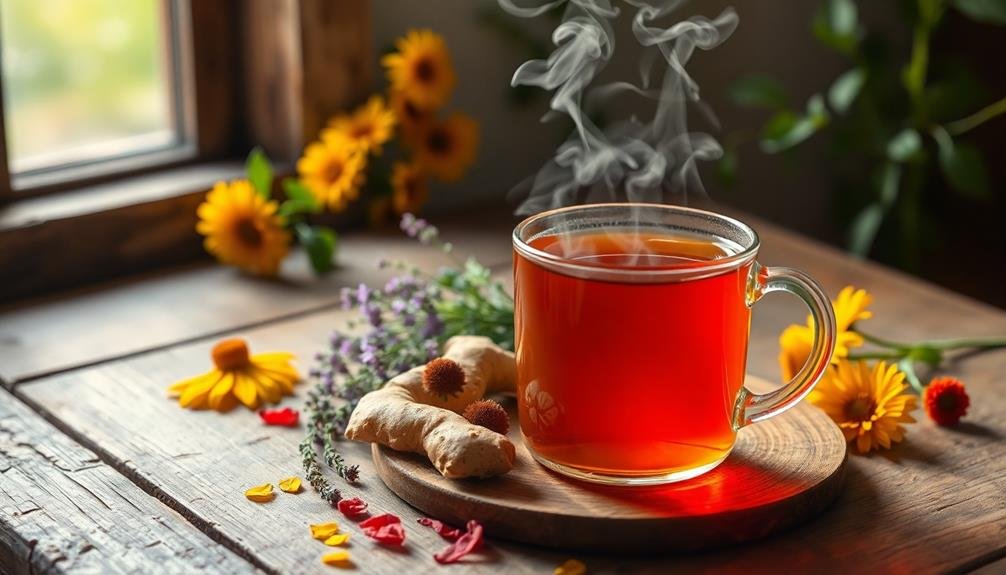
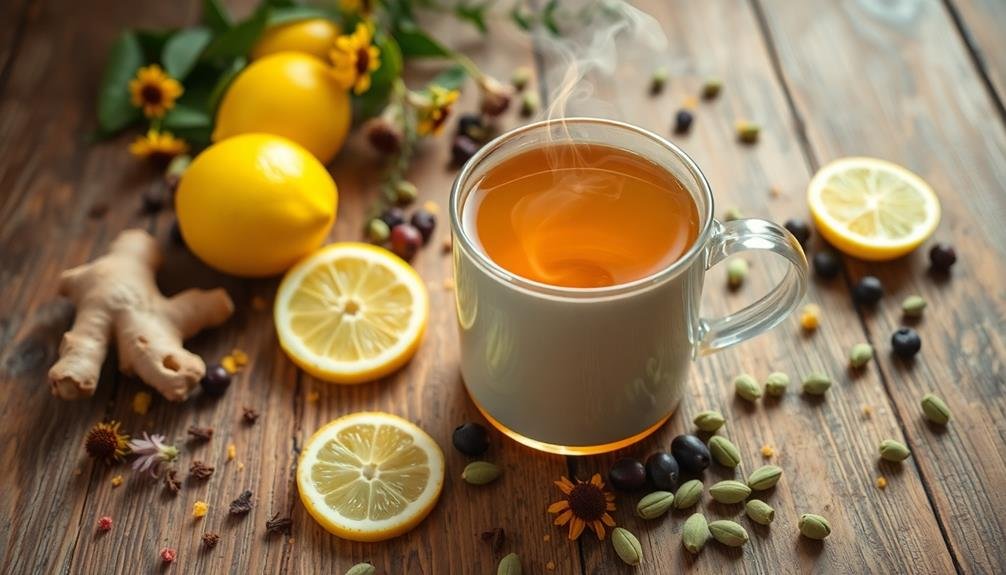
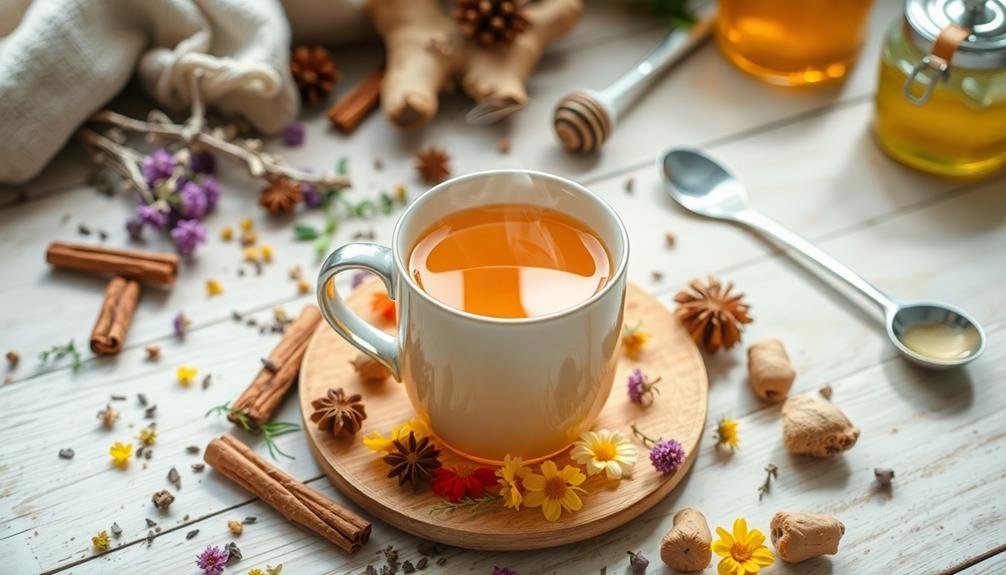
Leave a Reply